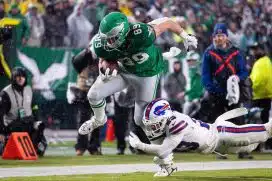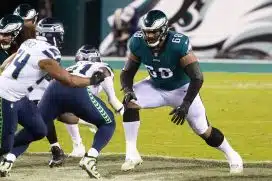By Tim Kelly, Sports Talk Philly editor
Many Millennials grew up playing the video game "Backyard Baseball," an early 2000s game that allowed you to play with the "kid" versions of superstars such as Barry Bonds and Randy Johnson. In the game, the color commentator, "Vinnie the Gooch," had a go-to line about Philadelphia sports fans, suggesting that they were "pretty tough" because they once booed Santa Claus.
The most popular edition of the game came out in 2001, 33 years after the infamous incident of fans throwing snowballs at Santa Claus during a 1968 Philadelphia Eagles game took place. In a strange way, a game where you could play for a team called the "Humongous Watermelons" worked to reinforce a stereotype about an entire group of people that they had no control over. Fast forward to 2017, nearly five decades removed from the incident, and it still defines Philadelphia sports fans in the minds of many.
During the 1968 Eagles season, the incident that has come to define Philadelphia sports fans took place:
Frank Olivo, who was in the stands wearing a Santa suit and fake white beard, was asked to fill in. But when he ran downfield past a row of elf-costumed "Eaglettes" and the team's 50-person brass band playing "Here Comes Santa Claus," thunderous boos erupted from the crowd of 54,535 and snowballs began raining down.
The halftime behavior during the team's final home game — which was broadcast around the country on Howard Cosell's national sports show — helped cement Philadelphia's reputation for rowdy sports fans.
Frequently, Philadelphia fans try to own the story. "We threw snowballs at Santa Claus," is often a line that fans use in a positive manner to suggest how difficult it is to earn the respect of Philadelphia sports fans. But there does seem to be a generational divide in the level of disgust that a mention of the incident garners.
Not that they are the first to feel this way, but Millennials, including Liberty University student Adam Fornwalt, are generally tired of an incident that happened decades before they were born defining the fanbase that they are a part of.
"It is ridiculous that every Philadelphia sports fans is lumped into one incident," Fornwalt, who is 23, said. "The incident happened so long ago. It's about time that people move forward and realize that there is a new generation of Philadelphia sports fans on the rise."
Fellow 23-year-old Dylan Huggins – who, when interviewed for the story, went out of his way to mention incidents that have taken place at Oakland Raiders and Los Angeles Dodgers' games that don't seem to define those fanbases – shared similar sentiments to those of Fornwalt.
"I think it it is absolutely ridiculous that Philadelphia sports fans in 2017 still get crap for something that happened in 1968," Huggins said. "It's like the only thing that they [detractors of Philadelphia sports fans] have to hang their hats on is that 'Santa' had snowballs thrown at him. So all Philadelphia sports fans from 1968 and on are looked at as those who threw snowballs at Santa. It is ridiculous."
Popular: Eagles Aren't In A Position To Sit Offensive Starters In Week 17
When it comes to this incident, there seems to be a feeling from Millennials that there is no "we." Telling someone in their 20s or 30s that "we threw snowballs at Santa Claus" is like telling them that they made "Hey Jude" the No. 1 song on the Billboard charts in 1968 or that they elected Richard Nixon that same year. It would be like blaming a young banker on Wall Street decades from now for the subprime mortgage crisis. It doesn't seem to make much sense.
Millennials, of course, aren't the first generation to realize how silly generalizations about entire cities based on individual incidents are. The incident in question took place during the final week of the 1968 NFL season, meaning those 49 years old or younger, which certainly encompasses more than millennials, weren't even alive when the incident took place. Even those who were alive at the time, and 99 percent of those who attended the game, had nothing to do with the incident. (That doesn't even take into account the fact that booing someone wearing a Santa costume and hitting him with snowballs may not be nice but probably shouldn't qualify as an "incident.")
But as Fornwalt suggested, this is a new era of Philadelphia sports fans. Millennial Philadelphia sports fans may have seen the Eagles and Phillies play in Veterans Stadium, but they don't identify with the culture that existed there. To them, Lincoln Financial Field and Citizens Bank Park, for better or for worse, are the homes of their respective teams. Franklin Field, where the Santa incident took place, is more synonymous with the Penn Relays than Eagles football to Millennials.
Christmas night, the sports world focused its eyes on Philadelphia, which hosted the Eagles Monday Night Football battle with the Oakland Raiders. The game wasn't short on Santa references. Whether you heard those references or happen to still have a copy of Backyard Baseball 2001 lying around, Millennials that root for Philadelphia teams would like you to reject the Santa story defining this generation of Philadelphia sports fans. In their minds, there is no "we."







